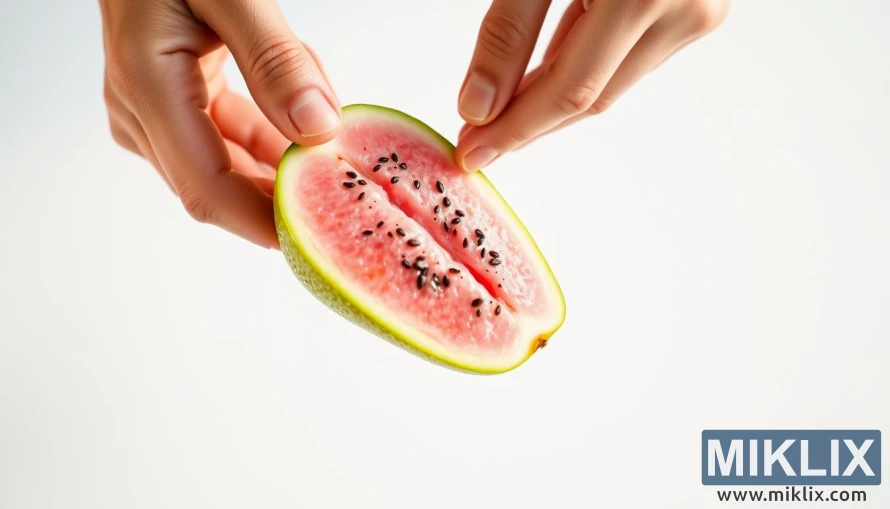Image: Hands peeling fresh guava fruit
Published: May 21, 2025 at 10:07:04 AM UTC
Last updated: September 25, 2025 at 9:05:55 PM UTC
Detailed close-up of hands peeling ripe guava with green skin, pink flesh, and black seeds, highlighting its vibrant texture, flavor, and healthful appeal.
In this evocative image, the guava is presented not as a mere fruit but as an intimate focal point of human interaction. Two hands hold a halved guava with gentle care, the fingers positioned delicately, almost reverently, around its vibrant form. The guava itself is a striking study of contrast and natural beauty: its outer skin shines with a vivid green hue tinged with yellow undertones, while the interior bursts forth in radiant shades of pink that deepen toward the center. Tiny black seeds are scattered throughout the flesh, their glossy surfaces catching the soft light, providing a rhythmic texture that balances the smoothness of the fruit’s interior. The clean, bright background isolates the guava and the hands, allowing every detail of color, texture, and gesture to be absorbed without distraction.
The lighting is warm and inviting, cascading evenly across the guava’s surface and accentuating the fruit’s juiciness. The pink flesh glistens as though freshly cut, moist and bursting with ripeness, promising a refreshing sweetness tempered by a subtle tang. The seeds, though small, create focal points that guide the viewer’s eye naturally across the length of the fruit, their placement emphasizing the symmetry of the guava’s form. The outer skin, still intact along the edges, frames the inner glow of the flesh, creating a visual harmony that is both vibrant and calming. It is a portrait of ripeness, an image that speaks not only to nourishment but also to the sensory delight of taste and touch.
The hands themselves add a vital layer of intimacy to the composition. Their presence transforms the fruit from a static subject into part of a lived experience. The fingertips hover with precision, poised to separate the layers of the guava, suggesting both anticipation and appreciation. This careful gesture conveys a quiet ritual of savoring food slowly, with respect for its texture, its flavor, and its natural origin. The viewer is drawn into this moment, invited to imagine the sensation of the smooth skin against the fingers, the cool, moist flesh yielding gently to touch, and the satisfying resistance of the seeds when bitten. This is not just a fruit; it is an encounter, a sensory dialogue between human and nature.
The simplicity of the background enhances this intimacy, offering a blank canvas that highlights the fruit’s vibrancy and the grace of the hands. There are no distractions, no competing colors or textures, only the purity of the guava and the delicate gestures that accompany it. This sparseness elevates the scene to something almost meditative. It becomes a reminder of the beauty found in life’s simplest pleasures—the act of peeling, holding, and tasting a fresh fruit. The moment is quiet yet rich, understated yet profound, celebrating the connection between nourishment and presence.
The image also carries subtle symbolic undertones. The guava, with its lush pink interior encased in a protective green skin, embodies both resilience and generosity. The act of peeling or parting it open represents unveiling hidden sweetness, much like the small rituals we perform to find joy in everyday life. The hands, steady and careful, reflect mindfulness, transforming the fruit into more than just food—it becomes a metaphor for patience, for care, and for appreciation of natural abundance.
Ultimately, this composition is more than a still life. It is a meditation on the sensory experience of eating, an ode to freshness and health, and a visual celebration of the guava’s dual nature as both sustenance and delight. The interplay of texture, color, and human touch creates a scene that is at once appetizing and contemplative, inviting the viewer to pause, to savor, and to reconnect with the simple pleasure of fruit enjoyed at its peak.
The image is related to: Guava Gains: How One Fruit Can Transform Your Health

